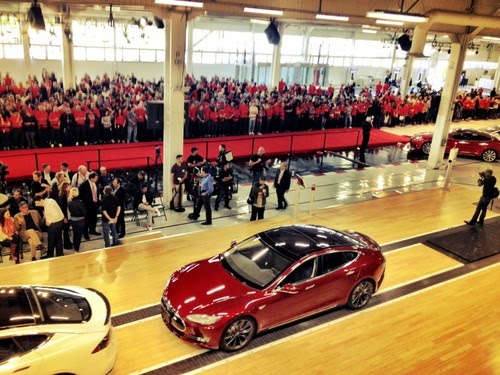Tesla Motors just released production figures for Q2 2016 — 18,345 vehicles for a 73,380/year annualized rate. This is the Tesla Model S and Model X, both of which target the luxury car market. The company also announced projected production rate increases for 2016, and that they should (knock on lithium) be able to produce 2400 vehicles per week by the end of 2016. That’s an annualized rate of 120,000 cars per year, or a 64% increase (if I’ve done the math right). These production increases lead towards the Tesla Model 3 launch at the end of next year, for which the intention is to hit the ground running producing a half million cars per year by 2018.
Details are in the announcement below.
Previously, Tesla Motors has been tight-lipped about production numbers. That’s left some journalists scrounging through DMV vehicle registration records to estimate production levels. It’s a breath of fresh air that Tesla Motors has released this much.
However, we do need to know more details. Such as per-region or per-country sales trends, and to deliver this report monthly rather than quarterly. All the other car companies report far more details than this, on a monthly basis.
In any case, what Tesla’s management tells us is:
- Steep increases in production — second half 2016 production to equal all of 2015 production
- Continued strong demand for Tesla Motors cars — outstripping production gains
Tesla Q2 2016 Vehicle Production and Deliveries
PALO ALTO, CA — (Marketwired) — 07/03/16 — Tesla (NASDAQ: TSLA) produced 18,345 vehicles in Q2, an increase of 20% from Q1, and exited the quarter consistently producing just under 2,000 vehicles per week. Due to the steep production ramp, almost half of the quarter’s production occurred in the final four weeks.
With continued productivity improvements, Tesla expects output to reach 2,200 vehicles per week in Q3 and 2,400 vehicles per week in Q4. Current order rate trends and backlog support production at those levels. In total, Tesla expects to produce and deliver about 50,000 vehicles during the second half of 2016, approximately equal to all of 2015.
Due to the extreme production ramp in Q2 and the high mix of customer-ordered vehicles still on trucks and ships at the end of the quarter, Tesla Q2 deliveries were lower than anticipated at 14,370 vehicles, consisting of 9,745 Model S and 4,625 Model X. In total, 5,150 customer-ordered vehicles were still in transit at the end of the quarter and will be delivered in early Q3. That amount was higher than expected (there were 2,615 vehicles in transit to customers at the end of Q1) and is more than a third of the number of cars that completed delivery in Q2.
* * * * *
There may be small changes to the Q2 delivery count (usually under 1%), as Tesla only counts a delivery if it is transferred to the end customer and all paperwork is correct.
Tesla vehicle deliveries represent only one measure of the company’s financial performance and should not be relied on as an indicator of quarterly financial results, which depend on a variety of factors, including the cost of sales, foreign exchange movements and mix of directly leased vehicles.
Forward-Looking Statements
Certain statements in this press release, including statements regarding future vehicle deliveries and vehicle production rates, are “forward-looking statements” that are subject to risks and uncertainties. These forward-looking statements are based on management’s current expectations. Various important factors could cause actual results to differ materially, including the risks identified in our SEC filings. Tesla disclaims any obligation to update this information.
Source: Tesla Motors, Inc.
- Is there enough Grid Capacity for Hydrogen Fuel Cell or Battery Electric cars? - April 23, 2023
- Is Tesla finagling to grab federal NEVI dollars for Supercharger network? - November 15, 2022
- Tesla announces the North American Charging Standard charging connector - November 11, 2022
- Lightning Motorcycles adopts Silicon battery, 5 minute charge time gives 135 miles range - November 9, 2022
- Tesla Autopilot under US Dept of Transportation scrutiny - June 13, 2022
- Spectacular CNG bus fire misrepresented as EV bus fire - April 21, 2022
- Moldova, Ukraine, Georgia, Russia, and the European Energy Crisis - December 21, 2021
- Li-Bridge leading the USA across lithium battery chasm - October 29, 2021
- USA increasing domestic lithium battery research and manufacturing - October 28, 2021
- Electrify America building USA/Canada-wide EV charging network - October 27, 2021
















